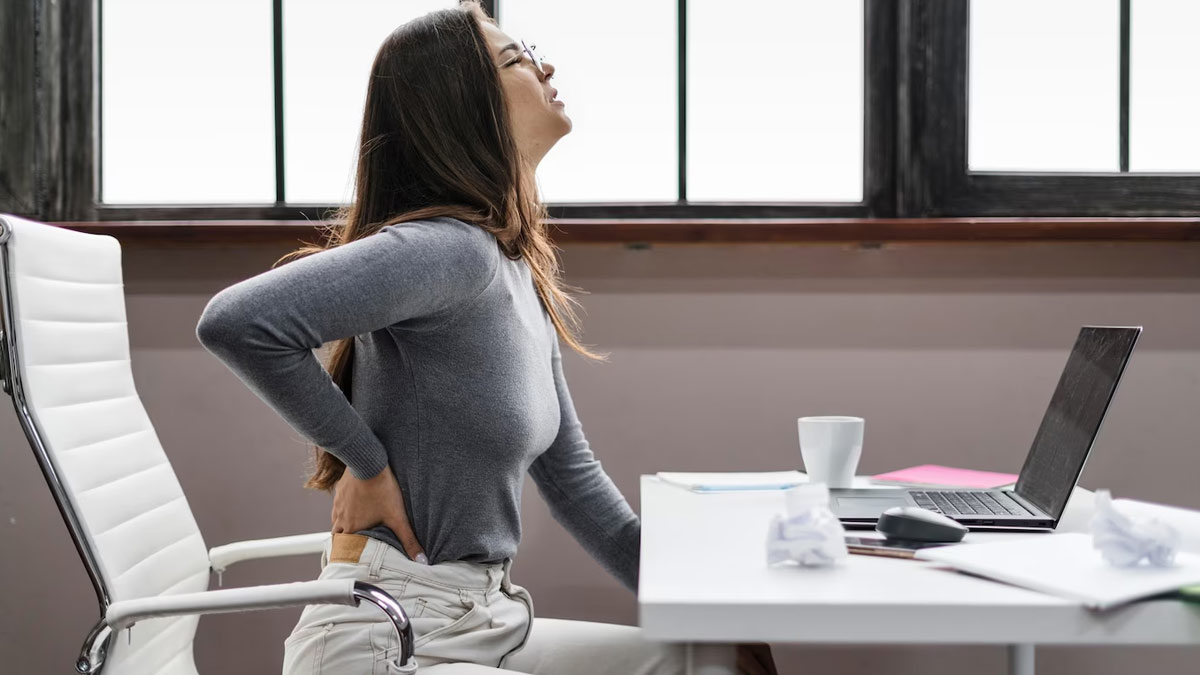
The sensation of persistent discomfort or pain in the lower back region is frequent in adults, mostly women. Lower back discomfort is sometimes associated with adulthood and affects people as young as 30 years old. Lumbago is a medical term that refers to an umbrella term that encompasses all lower back-related disorders.
Table of Content:-
What Exactly Is Lower Back Pain?
The lower back, or lumbar region, is an important part of the body responsible for providing stability, supporting movement, and protecting the spinal cord. It consists of complex structures, including vertebrae, intervertebral discs, muscles, ligaments, and nerves. When any of these components experience dysfunction or damage, lower back pain can arise.
The Multifaceted Causes of Lower Back Pain
Poor Posture And Ergonomics
According to Dr Abhishek Chatterjee, Certified Personal Trainer, ACSM, SWITCH Wellness, slouching or sitting inappropriately for prolonged periods can strain the muscles and ligaments of the lower back, leading to discomfort.

Muscle Imbalances And Weakness
Weak core muscles, tight hip flexors, and imbalanced muscle development can contribute to lower back pain.
Sedentary lifestyle
Lack of regular physical activity weakens the supporting muscles, making the lower back more vulnerable to pain.
Herniated or degenerative discs
Discs act as cushions between vertebrae. When they rupture or degenerate, they can press on nerves, causing pain.

Spinal stenosis
Narrowing of the spinal canal can put pressure on the spinal cord or nerves, resulting in lower back pain.
Scoliosis and other structural abnormalities: Irregular spinal curvature can strain the lower back and lead to chronic pain.
Also read: Struggling With Lower Back Pain? 5 Exercises Making Your Back Hurt
Psychological factors
Stress, anxiety, and depression can intensify lower back pain or contribute to its development.
Unique Approaches To Find Relief
Targeted Exercises
Engaging in exercises that strengthen the core muscles, stretch tight muscles, and improve posture can alleviate lower back pain.
Mind-Body Techniques
Practices like yoga, tai chi, and mindfulness meditation can help reduce stress, improve flexibility, and promote relaxation, thereby alleviating lower back pain.
Ergonomic Adjustments
Making modifications to workstations, chairs, and sleeping surfaces can promote proper alignment and reduce strain on the lower back.
Physical Therapy
Seeking guidance from a physical therapist can provide tailored exercises, manual therapy, and education on posture and body mechanics.
Alternative Therapies
Options like acupuncture, chiropractic care, and massage therapy may provide relief for some individuals.
Pain Management Strategies
In certain cases, medications, injections, or surgical interventions may be considered, particularly for severe or chronic conditions.
Preventing Future Episodes of Lower Back Pain
Regular Exercise
Engaging in a balanced fitness routine that includes aerobic exercises, strength training, and flexibility exercises can help maintain a healthy lower back.
Proper Lifting Techniques
When lifting heavy objects, utilising the legs and avoiding excessive strain on the back can prevent injury.
Maintaining a healthy weight
Excess weight places additional stress on the lower back, so maintaining a healthy body weight can reduce the risk of pain.
Also read: Suffering From Sciatica Or Lower Back Pain? Here's When You Might Need Surgery
Practising good posture
Maintaining proper alignment while sitting, standing, and walking can alleviate strain on the lower back.
Stress management
Employing stress reduction techniques, such as mindfulness and relaxation exercises, can help prevent stress-induced lower back pain.
Lower back pain is a complex and challenging condition, but by understanding its multifaceted causes and exploring unique approaches for relief, individuals can regain control of their lives.
Also watch this video
How we keep this article up to date:
We work with experts and keep a close eye on the latest in health and wellness. Whenever there is a new research or helpful information, we update our articles with accurate and useful advice.
Current Version